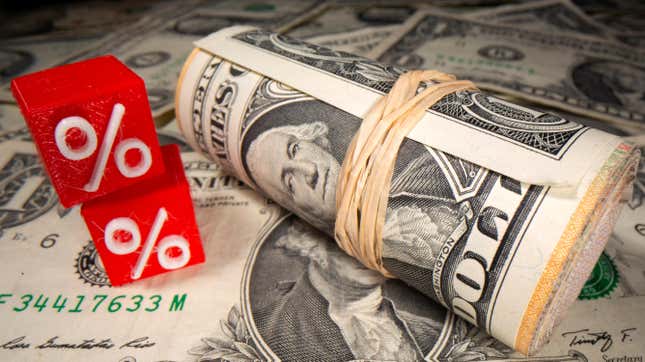[ad_1]

You borrow money, you pay it back. If you can’t pay it back right away, you might pay some money on top of that. Well, Americans are paying a lot of money on top right now: Data from the U.S. Bureau of Economic Analysis (BEA) suggests that consumers spent a record $1.1 trillion on interest payments last quarter.
What’s more, in a major shift, nearly half of that spending was not on mortgages. Data on so-called “personal interest payments,” which includes all non-mortgage debt, was released last week as part of an update on U.S. gross domestic product.
It’s not that there has been a sudden decrease in mortgage interest spending, it’s that higher rates from the Federal Reserve are hitting so many other categories so hard at the same time.
The Fed raised rates to the highest levels in two decades in order to cool down the economy and bring inflation back in line with its long-term 2% goal. The U.S. central bank has repeatedly stated its intentions to leave rates high until that happens despite expectations that it might move sooner than that. Its favorite inflation gauge, the personal consumption expenditure price index, came in at 2.6% for February, suggesting there’s still a bit longer to wait before rates come down.
The BEA calculates the mortgage interest figure by multiplying all outstanding mortgage debt by an “effective” rate calculated by the Federal Reserve. That rate sits at just 3.8%, far below the 6.9% that new homebuyers are facing on average for a 30-year, fixed-rate mortgage.
Credit card rates, which make themselves felt in wallets much more immediately, have jumped from less than 15% on average in February 2022 to nearly 21.5%. Data from the Federal Reserve Bank of New York (pdf) suggests that there has been a big spike in the amount of credit card and auto loan debt going into delinquency. And that’s on top of student loans coming back into the economic picture.
“The dominance of the 15-30-year fixed-rate mortgage has played a significant role in blunting the impact of higher rates on aggregate household debt service,” head of U.S. regional economics at the credit rating agency Fitch, wrote in a commentary in November. “However, the sharp increase in credit card rates and the resumption of student loan payments will drive non-mortgage household debt service to historic highs in 2024.”
[ad_2]
Source link




